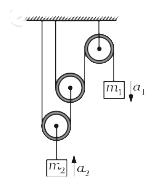A body performing nonuniform circular motion experiences linear acceleration ar and tangential acceleration aT, such that ar changes the direction of linear velocity. Then the resultant acceleration 'a' in this case is ,
√a3T+a3T
a=ar+aT
a=√a2r+a2T
a=√a2ra2T
The correct Answer is:C
Step by step video, text & image solution for A body performing nonuniform circular motion experiences linear acceleration a_(r) and tangential acceleration a_(T), such that a_(r) changes the direction of linear velocity. Then the resultant acceleration 'a' in this case is , by Physics experts to help you in doubts & scoring excellent marks in Class 12 exams.
Updated on:21/07/2023Topper's Solved these Questions
Similar Questions
Knowledge Check
For a particle performing a uniform circular motion the acceleration is
Aconstant in directionBconstant in magnitude but not in directionCconstant in magnitude and directionDconstant neither in magnitude nor in direction.In case of a uniform circular motion, velocity and acceleration are
AperpendicularBin same directionCin opposite directionDnot related to each otherFind the relation between acceleration a1 and a2
 Aa1=2a2Ba1=4a2Ca1=a2Da1=3a2
Aa1=2a2Ba1=4a2Ca1=a2Da1=3a2
Acceleration in circular motion|| Tangential acceleration|| Radial acceleration|| Shape OF path & net Acceleration
View SolutionIf the angle between tangential acceleration and resultant acceleration in non ucm is a, then direction of the resultant acceleration will be
View SolutionIn a uniform circular motion , the direction of linear velocity is along the
View SolutionIn a uniform circular motion , the direction of linear velocity is along the
View SolutionIn nonuniform circular motion, the linear acceleration →a, the angular acceleration, →α, the angular velocity →v the radius vector →r and the angular velocity →ω at any instant are related by the vector equation,
View Solution